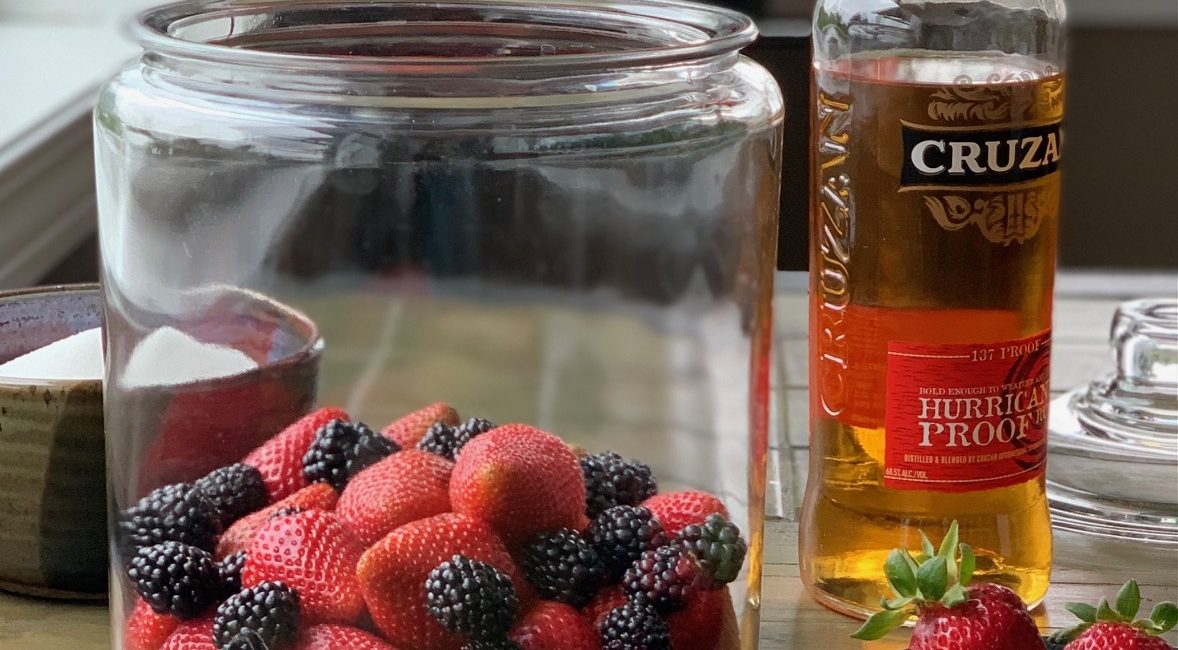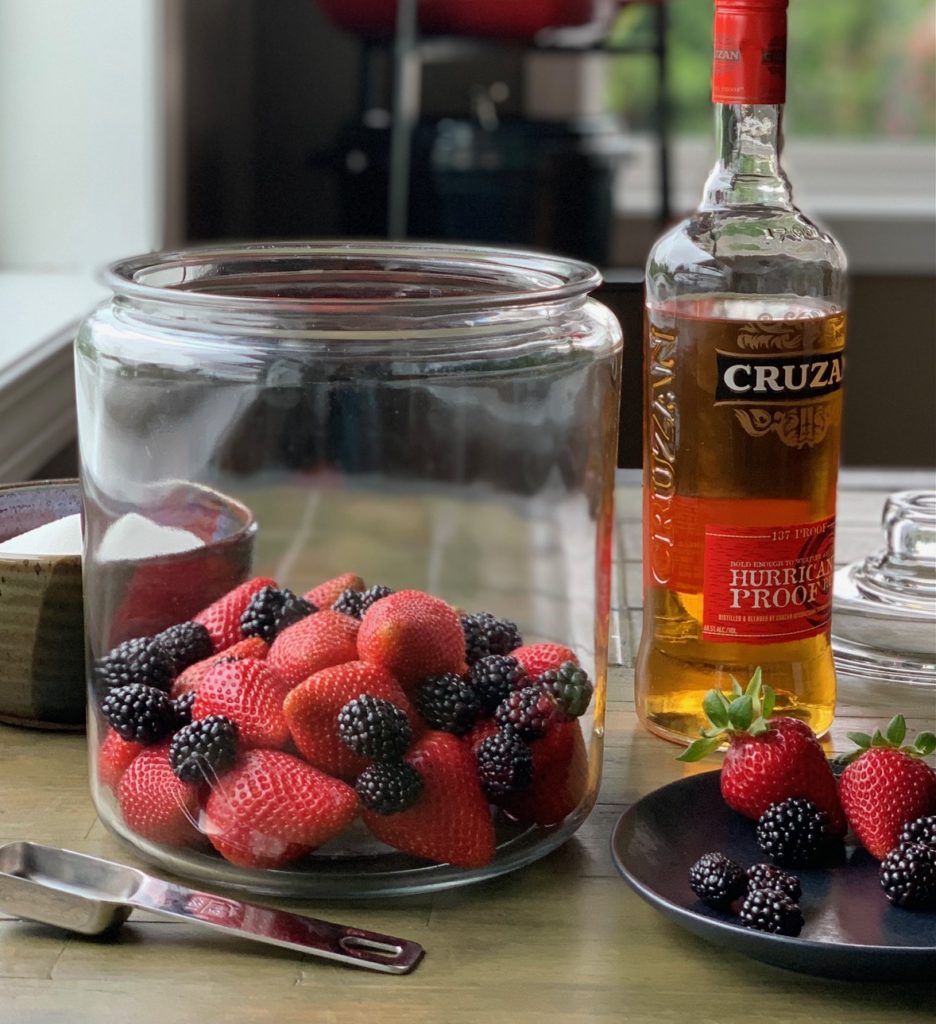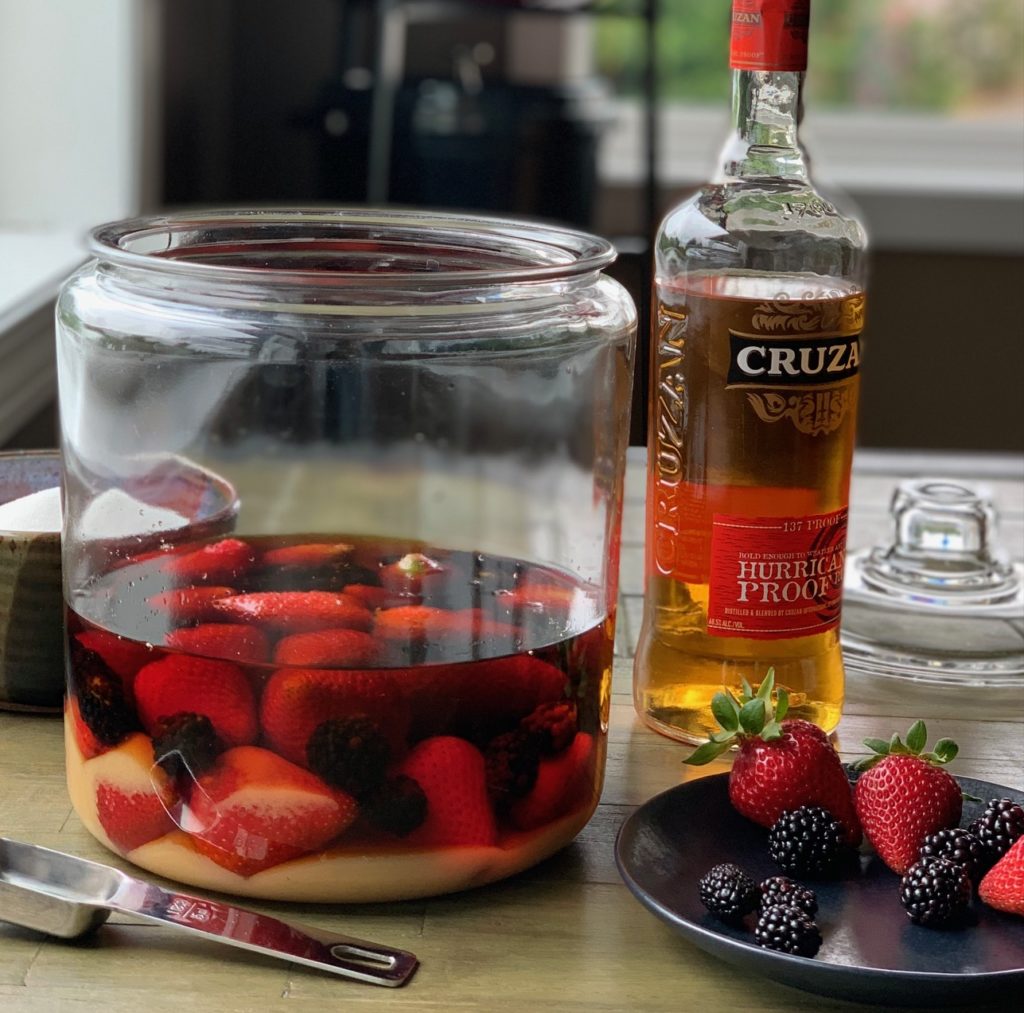Rumtopf


Northwest berry season is here! Rows of bright, colorful cartons stuffed with fragrant gems fill the market, each one beckoning you to take some home. Commemorate the summer and preserve some of our spectacular fruit by making Rumtopf, a delicious, boozy German fruit compote traditionally enjoyed during the end-of-the-year holidays. Start right now with berries, cherries and apricots, then continue through the summer, adding fruits as they ripen. At the end of the year, you’ll have captured the flavors of the whole season in a liquor laden treat filled with a delicious boozy bounty.
Rumtopf is typically made in a large stoneware pot, or rum pot. Some fruits, like strawberries, cherries, peaches, apricots, pears and grapes should always be included in a Rumtopf. Some fruits are not recommended and should be added at your discretion. These include apples, bananas (never!), blackberries, blueberries, citrus fruits, huckleberries, melons and rhubarb. I found out about the blackberries after I added them, but I love them, so I’m willing to take a chance. Add other fruits as you like, finishing with the final addition of pineapple in the fall.
Avoid any fruit you wouldn’t eat, such as fruit with bruises, mold, or anything that is overripe. The fruit must be thoroughly washed and patted dry, and the jar must be sterilized. Give your berries a 5 minute soak in water mixed with 2 tablespoons of white vinegar to clean them and kill off any mold spores or bacteria. I like to use my salad spinner when I have to soak a large amount of berries. Let the berries air dry if you have time, or you can speed things along by using a small fan, a great tip I learned from my CSA farmer.
A 3-gallon crock is typical, but gallon canning jars can be used as needed. As long as the container can be closed tightly, you can use it. A 3-gallon recipe will make 25 servings, but the resulting product will depend on how much fruit, sugar and rum you add to your jar. The fruit may change colors and this is normal. Keep your Rumtopf tightly lidded, in a cool, dark place. You may want to add a piece of plastic wrap under your cover to safeguard against evaporation. Watch the alcohol level and top off as needed.
The rum used is usually an overproof rum (108 proof, 54 percent ABV or higher) which helps to preserve the fruit. Austrian Stroh, an 80 proof rum, is also a good choice. You can dilute Bacardi 151 or Gosling 151 with regular, 80-proof rum, which is less expensive. Use an approximate ratio of 2:3—2 parts 151 proof to 3 parts 80 proof and remember to be careful when handling overproof rum, it is highly flammable.
Every time you add fruit, you will need to add sugar and rum as well to keep the fruit submerged. After the last fruit is added, you will need to let it rest at least 4 weeks before enjoying, but there is no rule that forbids you from tasting the fruits earlier. This is a very boozy recipe, so it’s not meant to be served to children or anyone who needs to avoid alcohol. At Christmastime, share your Rumtopf by ladling into smaller jars for friends or neighbors. Use the deliciously infused fruit to top pound cake or bake into cakes, spoon over yogurt, serve with ice cream or waffles, or puree the fruit and rum and freeze it to make a rum pot sorbet. Make a sauce for ham or use it to baste roasted pork, chicken or beef. There will always be more rum than fruits in the jar, so you will have some “leftover rum”. Add a tablespoon or two of rum to your coffee or tea, or to your champagne glass, and celebrate!
Savor the moment and make the most out of what you have. Preserve summer. Make Rumtopf!
Rumtopf
- sugar
- rum
Fruit:
- apricots, halved and pitted
- cherries, stemmed and pitted
- gooseberries, stemmed but whole
- grapes, stemmed but whole
- nectarines, halved and pitted
- peaches, halved and pitted
- pears, cored and slices
- pineapple, rind removed and cored, cut in cubes (or canned)
- plums, halved and piled
- raspberries, whole
- strawberries, hulled but whole
- optional: walnuts, raisins, 2 cinnamon sticks, 2 pods star anise, whole cloves, whole allspice
Step 1
Scrub container well with hot, soapy water. Rinse several times with boiling water, then rinse with a little rum.
Step 2
Wash, clean and cut fruit as directed above. Add your first fruit and sprinkle sugar on top, 1 cup for every pound of fruit. Top with enough rum to cover by 1 inch. Set in a cool, dark place for two weeks. Continue layering as fruits come into season, using any of the fruits listed. Layer with enough liquid to completely cover so that your Rumtopf infuses rather than ferments. If your fruit floats, use a ceramic plate to weigh it down and ensure that all of it remains covered with rum. If bubbles start to appear, add a little 151-proof rum to halt fermentation. End with final layer of pineapple and any optional ingredients, followed by sugar and rum.
Step 3
Allow to rest at least 4 to 6 weeks after the last fruit has been added.
Step 4
Use a ladle to dip down into the Rumtopf. Once the liquid level goes lower than the fruit, strain remaining liqueur, allow it to settle, then decant into bottles. Leftover fruit can be frozen until ready to use.

